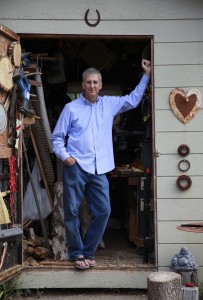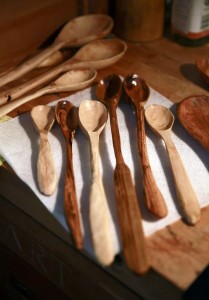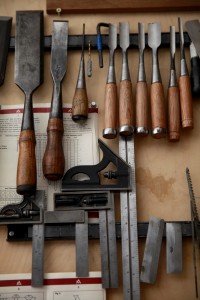Treen. It’s defined by Webster as “small household objects, such as utensils or dishes, made entirely of wood.”
Rick Gorman makes treen. By profession, Gorman, 55, is a banker with Bank of Marin. But for most of his life, woodworking has been something he deeply enjoys.
 “As a kid,” he said, “I always made stuff.” His dad, an engineer, had a table saw in the cellar and taught him the basics. When he got out of college, “I had no money, so I made my apartment furniture. I learned a lot of stuff from watching TV – this was before the Internet – shows like “This Old House and Yankee Workshop.”
“As a kid,” he said, “I always made stuff.” His dad, an engineer, had a table saw in the cellar and taught him the basics. When he got out of college, “I had no money, so I made my apartment furniture. I learned a lot of stuff from watching TV – this was before the Internet – shows like “This Old House and Yankee Workshop.”
When Gorman was in his 30s – “job eliminated, divorced, unemployed and homeless” he said wryly — “I decided to come to California and seek my fortune.” At first he lived in San Francisco, working as an executive recruiter. But he didn’t enjoy it and chose to take a year off. One day, he said, he saw an advertisement that intrigued him. “Learn woodworking,” it read, with the name and phone number of a man who ran a wood shop in an old coffee plant in the Mission District.
“At first,” he said, “I was going to go once a week, but after a while I was going every day.” Another woodworker observed what Gorman was doing and suggested he get in touch with Petaluma woodworker Michael Cullen, who was looking for an apprentice.
“Before I met Michael,” Gorman said, “I was into the Mission style, heavy oak, Arts and Crafts. But his pieces were light and airy, colorful, painted and carved stuff I’d never seen before. It blew me away and I said ‘Can you teach me how to do this?’
“He taught me how to do woodworking the real way, with hand planes, chisels and saws.”
After two years, though, Gorman decided that wasn’t what he wanted to with his life. He’d married again and he and his wife, Erica Burns-Gorman, had children — Amanda, Melanie, Lauren and Ben — so he returned to banking.
But his affection for woodworking didn’t go away, and he began making spoons. He’d made them as exercises while working with Cullen on intense, complex projects. “This was the opposite. Here’s a piece of wood, carve it out and see what happens. I liked that aspect. There wasn’t a lot of emotional attachment and, if it didn’t work out, you could do another one.”
A spoon isn’t like a piece of furniture with months of work invested in it, he said. “Spoons are fun.”
At the back of his garage workbench is a redwood slab, a gift he prizes for the beauty of the wood. It’s not for carving, he said. Redwood is splintery, difficult to work with, so it’s there only to admire. Above the bench is long, narrow oblong of wood he enjoys because the natural pattern on it is shaped like a spoon, including a deep indentation at the bowl end.
To the upper left are fold-out drawers that hold his tools. He shows several knives — blades bought from England, with the handles carved by him.
While Gorman doesn’t sell on line, he said there are many who do. He appreciates the impact of the Internet. “I can see what other people are doing. It’s amazing how many people post their projects and share information about techniques and tools.”
Gorman displayed a butternut bowl he made for his wife. The wood has a flaw in the middle – “it gives it character.” It’s the same with a chestnut bench. “When I bookended the wood, I discovered a flaw. Rather than discard it, I left it.”
He’s learned if he carves wood before it’s dry, it’s easier to work with. “But it’s a trade-off because when it’s drying, the wood can crack.” He mitigates this by sealing the object, with its damp shavings, in a plastic bag so it dries more slowly.
A new item he’s enjoying carving is a Finnish drinking cup – called a kuksa. The small cup has a beavertail handle that makes the cup a comfortable fit in a hand. “I like the way it looks and feels.”
People find out he makes spoons, he said, and give him wood. Or, “sometimes I stop on the side of the road and pick something up.”
 Pear – and he held up a spoon carved from the wood – is photosensitive, he said, becoming darker when exposed to sunlight. Another spoon is carved from an unknown type of fruit wood he pulled out of a burn pile. “I’m not a scavenger,” he said. “I feel like I’m saving them.”
Pear – and he held up a spoon carved from the wood – is photosensitive, he said, becoming darker when exposed to sunlight. Another spoon is carved from an unknown type of fruit wood he pulled out of a burn pile. “I’m not a scavenger,” he said. “I feel like I’m saving them.”
His current favorite wood is Osage Orange, originally from Oklahoma, he explained. A grove of the trees was apparently planted by the first Two Rock settlers because it was good for wagon wheels and fence posts. It’s dense, colorful and strong. It doesn’t rot.”
Gorman described his spoons as “everyday art – both useful and beautiful.” He makes several hundred each year, working on some every week, carving more around the holidays. He sells them at the Petaluma Farmers Market and said more than one person collects his spoons. “I like that it’s portable, I’m not tied to the workshop. I can carve almost anywhere.”
He enjoys the adventure of finding the wood, and then of working with it. “It’s always different, even with wood from the same tree.” He demonstrated with two spoons carved from the same log. “Look how they’ve come out. One is utilitarian, the other refined. Or, it’s a surprise.” Sometimes the wood tells him what it wants to be. Other times he decides, and once in a while, “it’s a dance.”
Those interested in purchasing Gorman’s spoons can stop by Saturday Farmers’ Market or e-mail him at rick 3914@aol.com.
